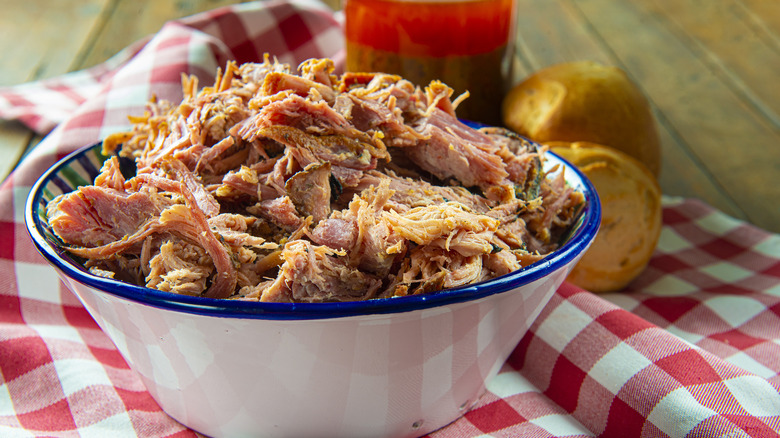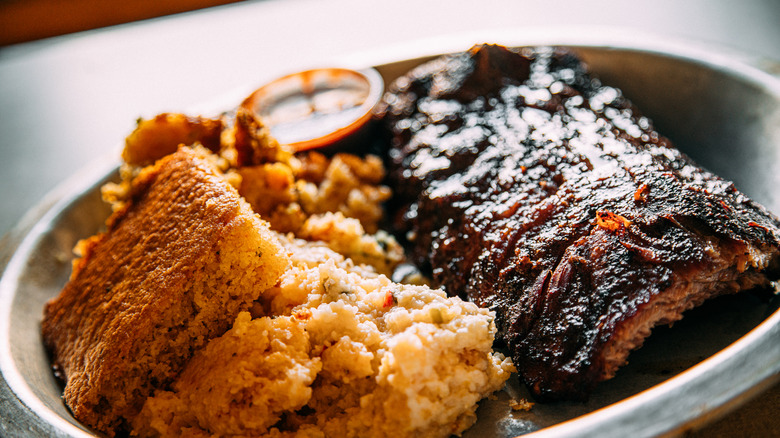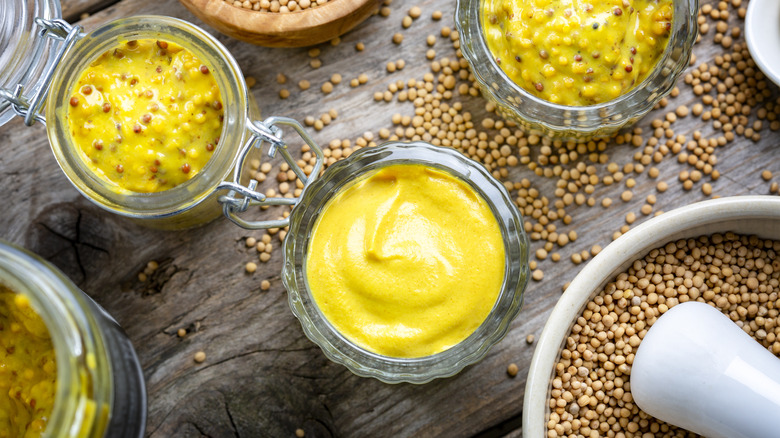North Carolina Vs South Carolina Barbecue: What's The Difference?
There may be nothing more American than barbecue. It's more than simply grilled or smoked meats; it is a reflection of America as a whole. Every region of the country seems to have its own barbecue style, from Kansas City's legendary tangy barbecue sauce to Memphis barbecue's wet or dry pork ribs to Alabama's white barbecue sauce to Texas, where brisket rules as king.
But nowhere is this more true than in the Carolinas, where several different competing styles of barbecue vie for supremacy. Nowhere is more barbecue diversity packed into one place in the United States than the Carolinas, where not only is there more than one style, but there are four: One in eastern North Carolina, one in western North Carolina, and two in South Carolina. Though all four barbecue varieties make heavy use of pork, the sauce varies significantly in all of them. Where other regional styles love to bring sweetness with things like brown sugar and molasses, most Carolina styles reject this approach. All of the sauces feature vinegar, but from there, they diverge wildly, with eastern North Carolina sticking to a thin vinegar-based sauce, while the western part of the state brings ketchup into the mix, and South Carolina goes mustard-crazy.
North Carolina's two barbecue styles largely come down to ketchup
Much as the state is eternally divided over college basketball, North Carolina is likewise divided by opinions over which barbecue style is superior. The OG Carolina barbecue style is that of the East, one of the older barbecue styles in the country. If you've ever had Eastern Carolina barbecue sauce, you'll know how distinct it is. It might have spices like salt, pepper, crushed red pepper, and cayenne, but two flavors are predominant: Vinegar (usually apple cider) and peppers. Ultimately, this style doesn't want anything else getting in the way of that vinegar flavor. As far as what kind of pork to use, eastern North Carolina barbecue isn't picky; the local expression is "use every part of the hog except the squeal."
Western Carolina barbecue, on the other hand, is of the opinion that just vinegar isn't quite enough. Also known as either Lexington- or Piedmont-style (for its origins in the city of Lexington in the Piedmont Triangle), western North Carolina barbecue is known for the primary component it adds to the sauce: ketchup. While this gives the sauce a little more sweetness, it's still vinegar-forward. Western Carolina barbecue is also a little pickier about which cuts to use, with pork shoulder predominating over all other options.
South Carolina's two barbecue styles are visually distinct
On the other hand, South Carolina's two barbecue styles are quite different from their northern cousins. There are two distinct styles in the Palmetto State: Pee Dee and Midlands. Pee Dee has a similar vinegar-based sauce to eastern North Carolina, but it's distinguished by turning up the spice level relative to its cousin. More importantly, though, Pee Dee barbecue is universally whole-hog cooking: The entire pig is slow-cooked for 12 hours or more.
But while Pee Dee barbecue has its fans, Midlands is what people think of when they think of South Carolina barbecue. It's not surprising if you've ever seen it because South Carolina barbecue sauce is the only one in the country that's a vibrant yellow owing to its active ingredient: mustard. Have you ever seen Carolina Gold barbecue sauce (distinct from Carolina Gold rice) on sale at the grocery store? That's Midlands South Carolina barbecue all the way. Though it's still a vinegar-based sauce, it's a lot sweeter than the other Carolina varieties, too, owing to the inclusion of brown sugar and honey. Typically, Midlands barbecue primarily uses pork shoulder and ham, but they aren't quite as picky about the cut as Western Carolina barbecue.
All four of these styles have their adherents, and all four bring something unique to the table. Try them all yourself and see which is your favorite.


